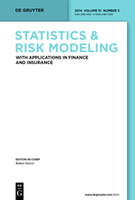
Statistics & Risk Modeling
Scope & Guideline
Fostering a deeper understanding of statistical science in practice.
Introduction
Aims and Scopes
- Statistical Risk Measures:
The journal emphasizes the development and application of statistical measures to quantify risk, including methodologies like Value at Risk (VaR) and Choquet risk measures. - Portfolio and Investment Analysis:
Research on portfolio selection strategies, emphasizing innovative approaches to optimize returns while managing risk, such as the use of Extended Gini Shortfall risk measures. - Modeling Financial Time Series:
A focus on time series analysis in finance, including VAR models and jump-diffusion models for better understanding and predicting market behavior. - Robust Statistical Methods:
An exploration of robust statistical techniques designed to handle massive datasets and ensure reliability in the presence of uncertainties. - Bayesian Approaches in Risk:
The application of Bayesian methods for investment and insurance strategies, incorporating dependencies between financial and insurance risks.
Trending and Emerging
- Complex Risk Models:
There is an increasing focus on multi-dimensional and systemic risk models that account for interdependencies and equilibrium strategies, reflecting the complexity of real-world financial systems. - Robust Estimation Techniques:
Emerging methodologies for robust estimation, particularly in high-dimensional contexts and massive datasets, are gaining traction, highlighting the need for reliable statistical tools. - Advanced Bayesian Methods:
The application of advanced Bayesian techniques in investment and insurance decision-making is on the rise, indicating a growing interest in incorporating uncertainty in risk assessments. - Non-linear and Asymptotic Analysis:
Research exploring non-linear models and asymptotic properties is becoming more prominent, particularly in the context of risk measures, suggesting a deeper analytical approach to risk modeling.
Declining or Waning
- Traditional VaR Backtesting:
Research specifically centered on traditional backtesting methods for Value at Risk appears to be declining, as more comprehensive and innovative approaches are being developed. - Simple Risk Models:
There is a noticeable decrease in the publication of studies focusing on simpler, less nuanced risk models, suggesting a shift towards more complex, multi-dimensional models. - Basic Statistical Techniques:
The use of basic statistical techniques without robust enhancements is becoming less frequent, indicating a trend towards more sophisticated methodologies and tools.
Similar Journals
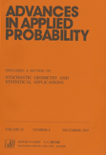
ADVANCES IN APPLIED PROBABILITY
Transforming Data into Decisions through Advanced ProbabilityADVANCES IN APPLIED PROBABILITY is a prestigious academic journal published by Cambridge University Press, focusing on the critical intersection of applied mathematics and probability theory. With an ISSN of 0001-8678 and an E-ISSN of 1475-6064, this journal emphasizes the development and application of probabilistic models in various sectors, enhancing the rigor and reliability of statistical methodologies. Established in 1969, the journal has evolved with converged years designated up to 2024, maintaining a steady release of cutting-edge research. As a Q2-ranked journal in both Applied Mathematics and Statistics and Probability categories as of 2023, it ranks favorably within the Scopus database, demonstrating its growth in influence and relevance within the academic community, with ranks of 141/278 and 353/635 in its respective fields. Although it does not offer open access, the journal remains a vital resource for researchers, professionals, and students seeking to advance their knowledge and understanding of probability applications across diverse disciplines.
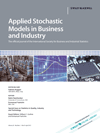
APPLIED STOCHASTIC MODELS IN BUSINESS AND INDUSTRY
Unlocking Insights Through Stochastic InnovationApplied Stochastic Models in Business and Industry, published by Wiley, is a preeminent journal dedicated to advancing the field of stochastic modeling in various business and industry contexts. With an ISSN of 1524-1904 and an E-ISSN of 1526-4025, this journal serves as a vital platform for researchers and practitioners aiming to leverage stochastic techniques to address complex decision-making and operational challenges. The journal holds prestigious rankings, including Q2 in Business, Management and Accounting, and has converged years spanning from 1999 to 2024. It is distinguished by its wide scope, focusing on all aspects of modeling and simulation, as well as decision sciences and operations research. Although it does not operate as an open-access journal, its significant impact factor and Scopus rankings ensure that the valuable insights published within reach a broad audience. By fostering high-quality research and discourse, Applied Stochastic Models in Business and Industry plays a crucial role in driving innovation and excellence in its fields.
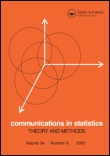
COMMUNICATIONS IN STATISTICS-THEORY AND METHODS
Exploring the frontiers of statistical science since 1976.COMMUNICATIONS IN STATISTICS-THEORY AND METHODS is a distinguished journal published by Taylor & Francis Inc, dedicated to advancing the field of statistics through rigorous theoretical and methodological research. With an ISSN of 0361-0926 and an E-ISSN of 1532-415X, this journal serves as an essential platform for statisticians, researchers, and academics to disseminate their findings and engage in scholarly discourse. It covers a broad spectrum of topics within the realms of statistics and probability, maintaining its relevance in the academic community, as indicated by its prestigious Q3 category rank and Scopus percentile ranking of 51st in its field. Launched in 1976, the journal has been pivotal in shaping contemporary statistical methodologies up to 2024 and offers a robust archive of knowledge and insights, despite its non-Open Access status. By fostering high-quality peer-reviewed articles, COMMUNICATIONS IN STATISTICS-THEORY AND METHODS continues to play a vital role in the development and dissemination of statistical theory, making it indispensable for students and professionals striving to stay at the forefront of statistical science.

Journal of Risk Model Validation
Empowering Decisions through Rigorous Model ValidationJournal of Risk Model Validation, published by INCISIVE MEDIA, is a pivotal scholarly platform dedicated to the fields of Applied Mathematics, Economics, Econometrics, and Finance. With an ISSN of 1753-9579 and an E-ISSN of 1753-9587, this journal actively contributes to the advancement of knowledge through the rigorous validation of risk models, which is essential for informed decision-making in business and economic contexts. Although currently not an Open Access journal, it serves a vital role in the academic community, evidenced by its categorization in the Q4 and Q3 quartiles across various relevant fields. As of 2023, it holds commendable Scopus rankings, reflecting its relevance and engagement within the global academic discourse. The journal encourages submissions from a wide array of researchers, professionals, and students until 2024, fostering a comprehensive exploration of risk model methodologies and their practical applications. Emphasizing both theoretical frameworks and empirical studies, the Journal of Risk Model Validation is an essential resource for those dedicated to enhancing the reliability and effectiveness of risk assessment in contemporary finance and economics.

STATISTICS
Advancing statistical science for a brighter future.STATISTICS is a distinguished journal published by Taylor & Francis Ltd, dedicated to advancing the field of statistical science since its inception in 1985. With a strong focus on both the theoretical and practical aspects of Statistics and Probability, this journal serves as a vital platform for researchers, professionals, and students seeking to disseminate their findings and contribute to critical discussions in the discipline. Although categorized in the Q3 quartile for both Statistics and Probability and Statistics, Probability and Uncertainty, the journal's commitment to quality research is evidenced by its inclusion in relevant Scopus rankings. It holds respectable positions, ranked #132/168 in Decision Sciences and #219/278 in Mathematics. By providing a venue for high-quality research articles and reviews, STATISTICS aims to foster innovation, reinforce methodological advancements, and address contemporary challenges in statistical applications. The journal does not currently offer open access, but it is widely distributed, ensuring that significant research reaches the communities that need it most. Researchers are encouraged to submit their work to this essential resource that continues to shape the landscape of statistical inquiry.

SIAM Journal on Financial Mathematics
Transforming Financial Challenges into Mathematical SolutionsThe SIAM Journal on Financial Mathematics, published by SIAM PUBLICATIONS, is a premier journal dedicated to the intersection of applied mathematics and finance. With an ISSN of 1945-497X, this journal serves as a vital platform for the dissemination of innovative research that addresses complex financial problems through mathematical modeling and analytical techniques. The journal has established itself within the Q2 quartile in the categories of Applied Mathematics, Finance, and Numerical Analysis, reflecting its influence and significance in these fields. Researchers and practitioners will find a wealth of knowledge spanning topics from stochastic calculus to quantitative finance, making it essential for anyone aiming to advance their understanding of financial mathematics. As the journal continues to converge from 2010 to 2024, it promises to remain a cornerstone resource for academics, professionals, and students alike, facilitating the ongoing dialogue between mathematics and its applications in the financial industry.
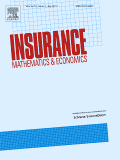
INSURANCE MATHEMATICS & ECONOMICS
Empowering scholars with cutting-edge insights in insurance mathematics.Insurance Mathematics & Economics, published by Elsevier, stands as a pivotal journal in the fields of economics and statistics, carrying the ISSN 0167-6687 and E-ISSN 1873-5959. Established in 1982, this journal aims to disseminate high-quality research that integrates insurance theory with economic principles, making significant contributions to both academic and practical spheres. With a notable Q1 ranking in the 2023 category quartiles for Economics, Econometrics, Statistics, and Probability, and a solid standing in Scopus ranks, it ranks #64 out of 278 in Mathematics and #45 out of 168 in Decision Sciences, showcasing its relevance and prestige in the research landscape. The journal not only facilitates a deeper understanding of insurance-related mathematical methodologies but also emphasizes the application of these techniques in real-world economic contexts. Researchers, professionals, and students alike can benefit from its rigorous approach to the challenges faced in insurance and economics, making it an essential resource for anyone involved in these dynamic fields.
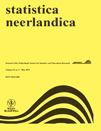
STATISTICA NEERLANDICA
Fostering excellence in statistical research since 1946.STATISTICA NEERLANDICA is a prestigious peer-reviewed journal published by Wiley, focusing on the fields of statistics and probability. Established in 1946 and addressing key issues in statistical theory and its applications, the journal has significantly contributed to the development of modern statistical practices. With an impressive Q2 categorization in both Statistics and Probability, as well as Statistics, Probability, and Uncertainty, STATISTICA NEERLANDICA stands out within its field, ranking in the 62nd percentile among its peers in mathematics, specifically in statistics and probability. Researchers, professionals, and students can benefit from its rigorous scholarship and innovative methodologies, aiding in the advancement of statistical science. Although the journal does not operate under an open access model, it maintains a commitment to disseminating high-quality research, making it a vital resource for those engaged in statistical inquiry.
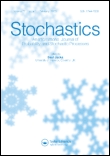
Stochastics-An International Journal of Probability and Stochastic Processes
Charting New Territories in Statistical AnalysisStochastics: An International Journal of Probability and Stochastic Processes, published by Taylor & Francis Ltd, is a pivotal platform for the dissemination of innovative research in the realms of probability and stochastic processes. Since its inception in 1975, the journal has evolved to encapsulate a rich array of methodologies and applications, contributing significantly to the fields of modeling, simulation, and statistical analysis. With a current impact factor ranking in the Q3 category for both Modeling and Simulation and Statistics and Probability, it positions itself as a valuable resource for professionals, researchers, and students alike. The journal’s coverage spans a unique historical arc from 1975, and it continues to push boundaries up to 2024, ensuring the latest trends and discoveries are accessible to an engaged audience. Though not Open Access, the journal’s scholarly contributions are crucial for advancing understanding and innovation in stochastic modeling, making it an essential read for those seeking to deepen their expertise in the field.

JIRSS-Journal of the Iranian Statistical Society
Empowering Statisticians Through Open Access Insights.JIRSS - Journal of the Iranian Statistical Society is a prominent academic journal dedicated to the field of statistics and probability, published by the esteemed Iranian Statistical Society. With its ISSN number 1726-4057 and E-ISSN 2538-189X, this journal serves as a vital platform for disseminating cutting-edge research and advancements in statistical methodology and its applications. Established in 2011, JIRSS has consistently contributed to the academic community, achieving a 2023 Scopus rank of #180 out of 278 in its category, placing it within the 35th percentile in the dynamic domain of Mathematics: Statistics and Probability. As an Open Access publication, it enhances accessibility for researchers, professionals, and students, facilitating a wider engagement with innovative statistical techniques and theories. The journal aims to foster collaboration and knowledge exchange among statisticians, ultimately enriching the field and its impact on various scientific disciplines.